Our Maize, Our Culture meetings and Native Seeds Funds in the improvement of the milpa as socio-ecological production landscape
09.04.2025
SUBMITTING ORGANIZATION
Centro de Formación en Agroecología y Sustentabilidad AC
OTHER CONTRIBUTING ORGANIZATIONS
None
DATE OF SUBMISSION
February 22, 2025
REGION
Central America
COUNTRY
Mexico
KEYWORDS
Milpa, seeds, farmer-to-farmer, agroecology, knowledge dialogs
AUTHORS
Munoz Villarreal, Oscar; Uribe Reyes, Joel; Morales Hernandez, Jaime; from the Agroecology and Sustainability Training Center AC (CEFAS) of the Network of Sustainable Agricultural Alternatives (RASA)
LINK
Summary Sheet
The summary sheet for this case study is available here.
1 Background
Mexico is the center of origin and diversification of maize (Zea mays) and there are 65 breeds and nearly 300 varieties. Mesoamerica, where the center and south of the country are located, is one of the eight places in the world where agriculture began more than 9,000 years ago. It is also one of the centers of origin of cultivated plants (about 50), including beans, pumpkin, tomato, cacao, vanilla, avocado, chili and many others that over time allowed the creation of a highly advanced agriculture, which was the basis of civilizations such as the Maya, Aztec, Olmec and Toltec.
The center of Mesoamerican agriculture has always been the milpa[1], a polyculture whose center is maize, in association with beans and squash, and around which up to 40 plant and animal species can develop. Historically, maize and its milpa organize the rural territory in Mexico and are the vital socio-ecological production landscape in the country’s culture and food. The milpa has been recognized by the FAO as one of the Globally Important Agricultural Heritage Systems (GIAHS); also the Mexican cuisine, based on maize, has received the designation of Intangible Heritage of Humanity by UNESCO.
Jalisco state, where this project takes place, is located in the western part of the country, on the edge of the Pacific Ocean and is crossed by the Western Mountain Range. This location has allowed the development of a great biological diversity and also a wide cultural diversity: it is here where the precursor of maize, teocintle (Zea diploperennis), whose domestication gave shape to the milpa, emerged some 10,000 years ago, making the state the center of origin of socio-ecological diversity. Agriculture has had, therefore, a fundamental weight in the social, cultural, economic and political life of the state. Rural families have built a rich agrodiversity, where maize is the crop around which the landscape and the functioning of family agriculture, which is the majority, is organized and produces an important part of the food. Jalisco is home to 22 of Mexico’s maize breeds, and this agrodiversity is at serious risk from the advances of industrial agriculture.
[1] We rather keep the name milpa because it is closer in meaning to socioecological production landscape, while the name three sisters refers to 3 of the cultivated species.
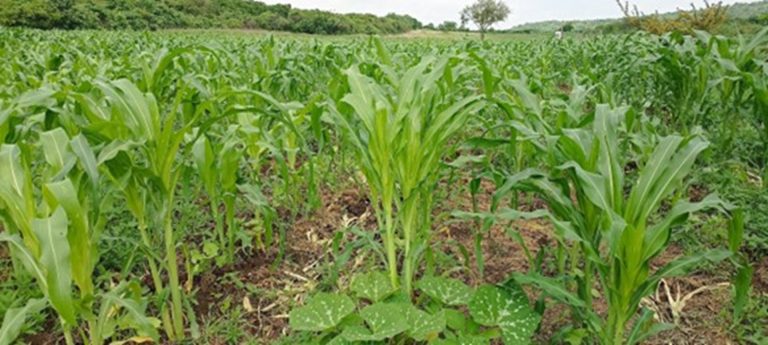
For more than 50 years, neoliberal industrialization and the green revolution have negatively impacted the region, destroying these socio-ecological production landscapes: first maize monocultures with hybrid seeds containing uncountable amounts of agrochemicals, and then agave and tomato monocultures caused migration, loss of flora and fauna, as well as deforestation of an important forest mass, the alteration of rain cycles and the drying up of important water sources, springs and streams. More recently, berry greenhouses have carpeted the landscape with plastic, so much so that farmer families now sarcastically call the Autlan region: The Nylon Plain, in reference to Juan Rulfo’s book: The Plain in Flames, a reality that is seen throughout the state; avocado monoculture has also contributed to the change of landscape, climate and social dynamics. In addition to all this, mining, urban expansion and drug trafficking have generated more violence and displacement.
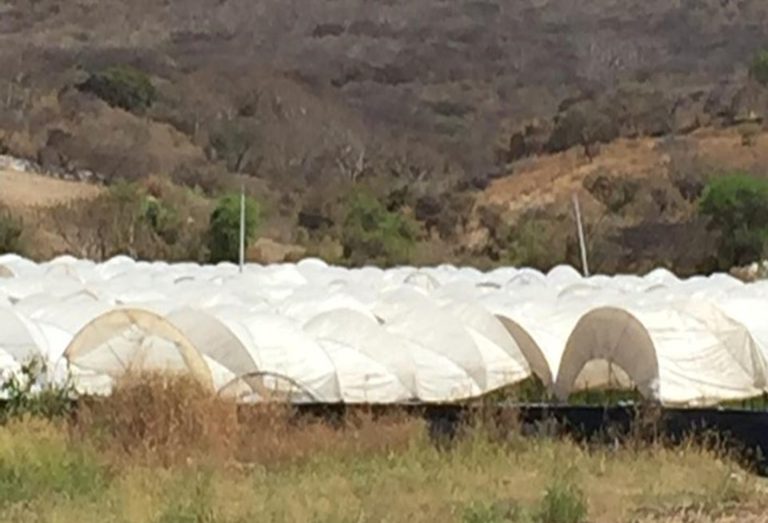
It is from this history that, in Jalisco, for more than thirty years, multiple initiatives have been built towards agricultures for peace that are sustainable and that allow for the reconstruction of socio-ecological production landscapes; it is in this path of collective construction where we can find the steps of the Network of Sustainable Agricultural Alternatives (RASA).
RASA was formally established in 1999, made up of farmers, indigenous people, women, neo-rural and urban consumers (100 families in 20 groups from different municipalities in Jalisco), in coordination with non-governmental organizations, universities and diverse collectives.
The Network has its own 2-hectareas Training Center for Agroecology and Sustainability (CEFAS), a space for training, research, experimentation and demonstration, in which there are different training modalities and where articulations and relationships with networks and organizations around agroecology, food and sustainability are promoted; this is also where one of RASA’s Native Seeds Funds is located.
The Network’s work focuses on training in agroecology, the care and improvement of the milpa and its seeds, and Fair Trade. Our working structure is very simple: the General Assembly makes decisions about the orientation of the Network and the topics to be promoted in each organization or each community. Each organization and each community decides on its priorities and activities. There is an Operational Coordination where family and organization representatives participate to facilitate communication and the realization of events.

The case study we present refers to the Our Maize, Our Culture meetings and Native Seeds Funds, since these activities occupy a very important place in RASA’s strategy of defense and care of the milpa, together with participatory plant breeding and articulation with other organizations.
These meetings have played a fundamental role in the care and improvement of milpa seeds, as well as the recovery of varieties in danger of extinction. In these meetings, the exchange and distribution of seeds of different milpa species is key, with emphasis on maize and its varieties, which renew and improve the Native Seeds Funds of the Seeds Keepers Families and of CEFAS itself. When seeds are exchanged, the knowledge associated with them, their agricultural management, traditions and culinary uses are shared.
For us, conducting this case study represents the opportunity to systematize our twenty-five years of experience and analyze the learnings and challenges of the Our Maize, Our Culture meetings and the Native Seeds Funds as key elements of our strategy in the care and improvement of the milpa and its agrodiversity as a dynamic socio-ecological production landscape.
2 Socioeconomic, environmental characteristics of the area
There are four types of forest landscapes in Jalisco state: jungles (at sea level), forests (up to 4,260 m), semi-arid and arid zones. In 2001 they totaled just over 4.8 million hectares; by 2022, 300,000 hectares had been lost, almost 14,000 hectares annually. The degradation of landscapes in 50 years is much more evident: from 1970 to 2022 the agricultural area went from 1.4 million hectares (with only 0.2 million catalogued as “susceptible to be opened to cultivation”) to 4.7 million hectares; hybrid maize: from 120,000 hectares to 300,000 hectares; maize for human consumption from 480,000 hectares to 460,000 hectares; agave from 2,760 hectares to 216,219 hectares. As a result of this destruction, 92 species of plants and animals are now in some category of risk.
The green revolution was intensively implemented in Jalisco more than sixty years ago, starting with monoculture maize technology packages, integrated by hybrid seeds and agrochemicals, which have been displacing native seeds and milpa. Since then, industrial agriculture has been the axis of policies in Jalisco and continues to advance over rural territories through monocultures, whether avocado, agave or berries, generating the collapse of family agriculture and a series of environmental problems (deforestation, water and soil contamination, erosion and desertification, and loss of agro-biodiversity) and social problems (migration, poverty and labor exploitation).
In Mexico, the so-called “modernization” of agrifood systems, imposed by neoliberal public policies, is characterized by technification and mechanization, with intensive use of natural resources and ecosystems, fossil energy and industrial inputs, mainly for monocultures oriented towards the external market and produced by large-scale corporate agriculture. In continuity with this, Jalisco’s countryside has been dominated by public policies aimed at favoring industrial agriculture that put maize and the milpa at risk as the center of the socio-ecological production landscape.
Our region is also affected by violence and narco-control of the territory: extortion, forced disappearances, clandestine graves, corruption of government bodies, the collection of quotas and money laundering are, among many others, a reality that, together with government agricultural policies, have forced the migration of young people and farmer families to the cities, which has broken the cycles of transmission of bio-cultural heritage and leaves the way open for the continued destruction and exploitation of socio-ecological production landscapes.
On the other hand, there is growing concern and interest in the production of healthy food, free of agrotoxins, as well as in the consequences of climate change, which has led to the multiplication of organic fairs and markets, as well as a greater city-countryside relationship.

One of the socio-political achievements is the declaration of the first agroecological municipality in Jalisco, El Limon, followed by the enactment of the Law for the Promotion and Development of Agroecology at the state level, in Colima state.
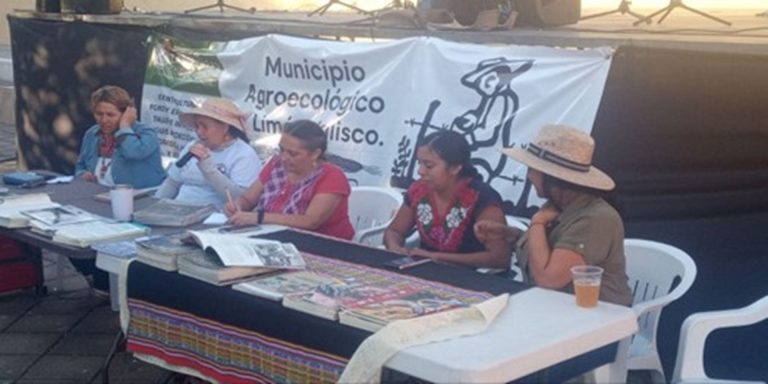
3 Objective and rationale
General Objective: To systematize and analyze RASA’s 25 years of experience regarding the Our Maize, Our Culture meetings and the Native Seeds Funds in the care and improvement of the milpa.
Rationale: although the Network has promoted a significant number of studies and publications on a wide variety of topics, especially maize and training processes, there has been no assessment of the importance of the Our Maize, Our Culture meetings and the Native Seeds Funds and their impact on the conservation of the milpa in family agriculture.
Outcomes: using the methodology of the meetings, to dedicate the Our Maize, Our Culture 2024 meeting to gather the experiences of communities and organizations in their processes of defense, recovery and renewal of their milpas as socio-ecological production landscapes. Likewise, to dedicate the content of the 2024 bulletin to making visible the impact that the work of the Network has had.
4 Detailed description of activities
Since our beginnings, we believe that the agro-diversity of the milpa is one of the key elements in the move towards more ecological, just and sustainable family farming, and that it makes the milpa a soioecological production landscape. We are part of the trajectory of Mexico and Jalisco where indigenous people, women and farmers, accompanied by researchers from some universities and social organizations, have carried out a continuous care and improvement of native maize seeds. In this journey we have defined the main elements of RASA’s strategy: a) the Our Maize, Our Culture meetings, where seeds and knowledge are exchanged, b) the Native Seed Funds, where the biocultural memory is reproduced as a socioecological production landscape, c) participatory plant breeding, which allows the co-evolution of seeds in the landscape and d) the articulation with other networks, which strengthens identity and socio-political incidence.
These activities clearly fall within two of IPSI’s objectives and sets of activities:
1 The Our Maize, Our Culture meetings as spaces for exchange about maize and its culture
The Our Maize, Our Culture meetings have played a fundamental role in the care and improvement of milpa seeds. They have been organized annually since 2004, with an average attendance of 100 people and a duration of two days; the venue changes among the communities that comprise RASA.

The host farmer group proposes a topic related to maize; together with the Operational Coordination, the methodology and focus of the meeting is designed, as well as the logistics to carry it out. Examples of recent topics addressed include: lessons learned during the pandemic, monocultures and the dispute over territories, agroecological municipalities, health and farmer rights, water, transgenics. Each of the themes responds to a local need that echoes, in general, with the rest of the communities in the region.
A printed and digital bulletin is always prepared, which is delivered during the meeting and is widely distributed, with information on the topic proposed by the host farmer group. The host group itself participates in the content, as well as other communities and specialists. It usually includes a song and a traditional dish, preferably from the host community, as well as some news or a review of a book or documentary.
During the meetings there are usually 4 main moments: 1) analysis of the reality, presented by farmers related to the subject, accompanied by technicians or specialists; 2) sharing of experiences on the subject and its relationship with the milpa; 3) celebration: seeds and fruits brought to share are always blessed, sometimes songs of yesteryear are sung, sometimes thanks are given, sometimes forgiveness is asked for; 4) seeds are exchanged (maize, its varieties, as well as other species of the milpa) and the knowledge and stories of each seed are shared; sometimes acknowledgements are given to those families or communities that, for example, have worked hard to reproduce and conserve a wide variety of seeds, that have recovered a species or variety that is in danger of extinction, or that have been great defenders of the milpa in their community and region.
These meetings not only share knowledge, but also feelings and flavors: they are moments of celebration and great joy, with spaces for the dissemination and marketing of products and food, they are a gastronomic and cultural event and include a wide range of activities such as talks, workshops, tours, plenary sessions, celebrations; in short, they are a festival to keep hope alive. The meetings bring together a very varied public that includes urban and rural farmers, indigenous people, consumers and advisors. This is, perhaps, one of the main elements that strengthens the group that receives the community, since it makes its work and the recognition and support that the Network gives it visible.
2 Native Seeds Funds as spaces for socio-ecological recovery, conservation and reproduction
Another element of our strategy has been the creation of Native Seeds Funds, in which different families experiment with the conservation, improvement and adaptation of their seeds, or others obtained during exchanges at the Our Maize, Our Culture meetings, to the changing conditions of their region. They select and care for the seeds that respond to their food habits, preferences and traditions, the varieties that are part of the beloved dishes inherited through different generations, as well as the new varieties that arrive in the exchanges. The RASA families have been trained to implement diverse techniques for seed improvement and the selection of the best maize plants and cobs. Thanks to the exchanges, 2 varieties that are in danger of extinction were recognized, and thanks to the Native Seeds Fund, the families of the Network have reproduced them year after year.
In CEFAS’s own physical space, varieties that circulate in the exchanges are kept in a Native Seeds Fund that is maintained collectively. It is made up of seeds from most of the farmers families that make up the Network, with a collection of more than 50 varieties of corn, as well as other milpa species. We also try to reproduce, adapt and improve them: about 10 varieties of corn, 2 of beans and 1 of squash have been tested and multiplied.
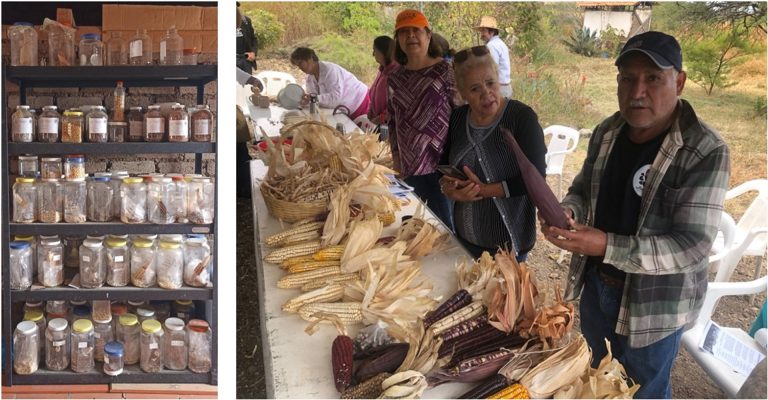
3 Participatory plant breeding
Another element has been participatory breeding and at CEFAS, since 2023, we began to work with the maize from our own Native Seeds Fund, under the technique of stratified mass selection in red pozolero maize. In order to carry out this process, activities have been implemented in the form of workshops, from planning, planting, maintenance and selection, to harvesting and conservation of seeds, which include a brief theoretical discussion and then proceed to carry out the activities in a practical way in the plot.
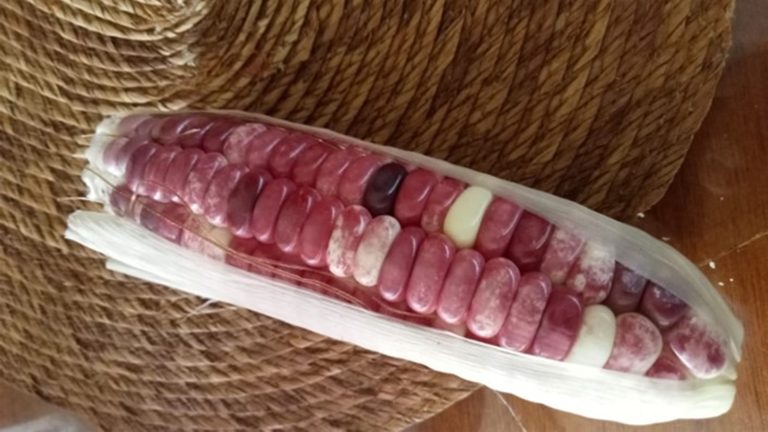
4 Linkage with other organizations
The Our Maize, Our Culture meetings are the result of the efforts, support and work of many organizations, movements and people who accompany us on this journey and share our dreams. Therefore, another element in the strategy followed by RASA is the relationship with diverse social movements for the defense and strengthening of the maize culture; for this, as a Network, we have close links with local and regional experiences in the care and conservation of native maize and, at the same time, we are part of movements and networks at a national level, participating in forums, events and regional and national mobilizations. In our journey we are accompanied by different organizations and social and citizen networks of farmers, environmentalists, women, indigenous people, local and regional consumers that participate and strengthen our activities, we also have working links with state universities and social enterprises. Relationships are at different levels and can be formal or informal, defined around mutual needs.
Some of our experiences in the care and conservation of maize and milpa have been compiled in three outrage publications, one of them co-financed by the Satoyama Foundation (see references at the end).
5 Results and lessons learned
The Our Maize, Our Culture meetings have been a suitable space for families to share and enrich their experiences regarding the milpa, the improvement of their seeds, the conservation of agrodiversity and their culture, and also to receive recognition, appreciation, support and encouragement to continue inheriting this heritage.
The participatory approach and the Farmer-to-Farmer methodology have been decisive factors because they value local knowledge and promote the exchange of experiences and experimentation to adapt different techniques and seeds, as well as to conserve agrobiodiversity and increase the resilience of these agroecosystems in the face of climatic adversities. By sharing their successes and failures, families reaffirm best practices that mimic natural processes, protecting the health of soil, water and biodiversity, which are fundamental ecosystem services.
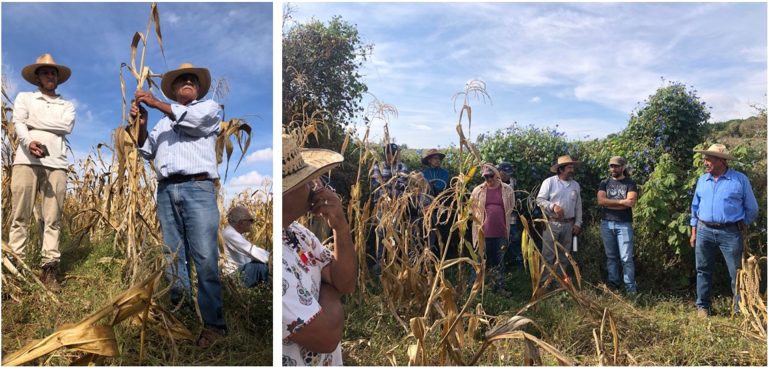
Another fundamental approach has been the Knowledge Dialogues because it has made the meetings multifaceted learning spaces where local and scientific knowledge is mutually enriched and innovations are proposed that can be better adapted to local contexts; some of these have been reflected in the bulletins generated for the meetings.
The seed exchanges that take place during the meetings have made it possible to conserve genetic diversity in the Native Seeds Funds, renewing varieties that are adapting to changes, as well as multiplying those seeds that had been lost in the community or region or that are in danger of extinction. In this task, the support of specialists has been decisive and it is a permanent challenge to follow up on the varieties present and exchanged in the meetings.
In terms of social recognition or valuation, the Native Seeds Funds have been a key aspect, not only because they ensure the long-term provision of food and the preservation of culturally rooted flavors, but also because they make the families involved be esteemed as Seeds Keepers, which strengthens their relationships in their community and favors the transmission of the biocultural heritage.
The festive atmosphere of the meetings reinforces the cultural appreciation of the fruits of the milpa and the families that cultivate them, generating an atmosphere of hope and joy. By sharing knowledge and flavors, culture is revitalized, identity is strengthened and values and traditions are transmitted from the palate to the new generations because seed conservation is connected to cultural identity and community values.
RASA’s social base has been consolidated and expanded: the meetings bring together diverse actors (farmers, indigenous people, urban, technicians, organizations) and strengthen the social fabric around agroecology and the defense of the milpa. A key factor has been the rotation of the venue because it ensures the attendance of families who otherwise would not be able to attend the meetings, strengthens the links between families and organizations, makes visible the work of the Seeds Keepers Families and the Network, and revalues the milpa as a socioecological production landscape from the fruits that are shared, whether through seeds, songs, meals or stories.
Native Seeds Funds contribute to food security and the construction of more sustainable and independent livelihoods. Native Seeds Funds promote autonomy because they allow families themselves to decide what, when and where to plant, according to a variety of factors, such as cultural traditions, incorporation of new varieties, climate, etc., in addition to diversifying the services provided by the milpa, such as food, water and energy, medicinal plants, recreation, spiritual strength… They also generate opportunities for the development of fairer and more sustainable local economies because they offer species or varieties that have been lost in the region and that agroindustry neither cultivates nor offers in its marketing channels.
All of these results contribute to the empowerment of local communities by giving them control over their resources. The best example of this is the municipality of El Limon, which has declared itself an agroecological municipality, the first in Mexico.
These results are understood as a constant struggle and active resistance to the various threats mentioned at the beginning. In addition, the financial sustainability of the meetings and conservation initiatives in the long term is a constant challenge. So, too, is the generational change in the communities, in the organizations and in the Network itself.
6 Key messages
At RASA, we are celebrating 25 years of weaving networks of hope and action so that native maize and the milpa continue to live, nourishing our culture and our territories. At the Encounters, ‘our long struggle becomes a celebration, and we see that we are not alone! There are reasons to continue planting and sharing our native seeds, which are our heritage and our future’.
In each Our Maize, Our Culture meeting, we not only exchange seeds, but also ‘the knowledge of our grandparents, the flavors of our land and the deep feeling of our milpa culture’.
Thanks to the Native Seed Funds, families demonstrate that ‘saving our seeds is saving our lives, our autonomy and the autonomy of our communities. They are the most valuable treasure we can pass on to our children.
RASA teaches us, in the words of technicians and farmers who collaborate with CEFAS, that ‘agroecology and the Knowledge Dialogues are the way to rebuild landscapes of peace and abundance, where the milpa flourishes and communities prosper’.
Despite the threats of monoculture and climate change, as RASA’s bulletins point out, the network shows us that ‘the defense of native maize is a celebration of cultural resistance, an act of love for our land and a commitment to a dignified future for new generations’.
7 References and bibliography
Alanis de La Rosa, J. A.; Mayorga Saucedo, R. (s/f) “Deforestacion” en Sistema Nacional de Monitoreo Forestal. Recuperado el 25 de enero de 2025. https://snmf.cnf.gob.mx/deforestacion/
Comision Nacional Forestal (CONAFOR). 2023. Estado que guarda el Sector Forestal en Mexico. Bosques para el bienestar social y ambiental. 1a ed. Mexico, D.F.: CONAFOR.
– https://infosen.senado.gob.mx/sgsp/gaceta/65/3/2024-04-02-1/assets/documentos/Libro_Estado_que_Guarda_el_Sector_Forestal_en_Mexico.pdf
Direccion General de Estadistica. 1975. V Censos Agricola-Ganadero y Ejidal 1970. Jalisco. Mexico, D. F.
– https://www.inegi.org.mx/app/biblioteca/ficha.html?upc=702825111250
INEGI. 2023. Censo 2022. Agropecuario. Resultados definitivos. Jalisco. Mexico, D. F.: INEGI.
–https://www.inegi.org.mx/contenidos/programas/ca/2022/doc/ca2022_rdJAL.pdf
Morales Hernandez, J. (ed.) (2011) La agroecologia en la construccion de alternativas hacia la sustentabilidad rural. 1a ed. Mexico: ITESO; Siglo Veintiuno Editores.
Munoz Villarreal, Oscar (2012) “Situacion de las hijas e hijos de campesinos agroecologicos de la Red de Alternativas Sustentables Agropecuarias, en Jalisco, Mexico”. Tesis de maestria, Pablo de Olavide University, Spain.
Munoz Villarreal, Oscar (2014) “Los jovenes en el medio rural, entre la crisis y la defensa de la memoria biocultural”. Pp. 159–70 en Los 43 que marcan a Mexico. Vol. Segundo Semestre, Analisis Plural. Tlaquepaque, Mexico: ITESO. https://rei.iteso.mx/items/ab709996-df2a-4855-9d5b-aae2bed00f46
Secretaria de Desarrollo Social. 2006. Programa Estrategico Forestal del Estado de Jalisco 2007-2030. Resumen Ejecutivo. 3a ed. Guadalajara, Mexico.
– http://www.conafor.gob.mx:8080/documentos/docs/12/1651Programa%20Estrat%C3%A9gico%20Forestal%20del%20Estado%20de%20Jalisco%20.pdf
8 Figures, tables and photos
Photo 1: Milpa from CEFAS Native Seeds Fund. Taken from: RASA Archive.
Photo 2: Plantation greenhouses located in the Jalisco municipality of Jocotepec. Taken from: RASA Archive.
Photo 3: Founding of RASA in Juanacatlan, Jalisco, 1999. Taken from: RASA Archive.
Photos 4 & 5: Organic flea market in Guadalajara (right) and Ajijic (left). Taken from: RASA Archive.
Photo 6: Public Ceremony for the signing of the “Declaration of Agroecological Municipality of El Limon, Jalisco”. Taken from; Rodolfo Figueroa, Organic Farmers Group, La Cienega, Municipality of El Limon.
Photos 7, 8 & 9: Our Maize, Our Culture 2024 meeting, Ixtlahuacán de Los Membrillos, Jalisco, Mexico. Taken from: RASA Archive.
Photos 10 & 11: CEFAS (left) & Maize House (right) Native Seeds Fund. Taken from: RASA Archive.
Photo 12: Red pozolero maize. Taken from: RASA Archive.
Photos 13 & 14: Our Maize, Our Culture 2024 meeting. Taken from: RASA archive.
9 Web links of any relevant organizations and projects
Network of Sustainable Agricultural Alternatives: https://www.facebook.com/RASA.Jalisco/
Agroecology and Sustainability Training Center AC: https://www.facebook.com/CEFAS.AC.JAL/
A Leap of Life: https://www.facebook.com/unsaltodevida/
Maize House: https://www.facebook.com/lacasadelmaiztlajomulco/
Cajititlan Lake Defense Network: https://www.facebook.com/RedDelLagoDeCajititlan/
Silks Agroecological Market: https://eljilote.org/
Farmer School (El Limon): https://www.facebook.com/EscuelaCampesinaEduPAS/
10 Recommendations for further reading
1 Articles
Gerritsen, P.; Morales Hernandez, J. (2009) “Experiencias de agricultura sustentable y comercio justo en el estado de Jalisco, occidente de Mexico” en Pueblos y Fronteras Digital, Vol. 4, Num. 7, Junio – Noviembre 2009, pp. 187-226.
Gerritsen, P. R. W.; Rosales Adame, J. J.; Moreno Hernandez, A.; Martinez Rivera, L. M. (2006) Conferencia “Sistemas productivos y sustentabilidad rural en la costa sur de Jalisco, en el occidente de Mexico” en XI Encuentro Nacional sobre Desarrollo Regional en Mexico en Merida, Yucatan, Mexico.
Morales Hernandez, J. (2014) “El cuidado y defensa del maiz nativo en Mexico: resistencias y acciones ciudadanas ante los transgenicos” en Analisis Plural, primer semestre de 2014. Tlaquepaque, Jalisco: ITESO. http://hdl.handle.net/11117/1478
Morales Hernandez, J.; Alvarado Castro, E.; Velez Lucero, L. (2014) “Los procesos de construccion de conocimiento agroecologico y la transicion hacia agricultura mas sustentables en Jalisco, Mexico” en Memorias del IX Congreso Latinoamericano de Sociologia Rural, http://hdl.handle.net/11117/2155
Morales Hernandez, J. (2022) “La Agricultura industrial y la disputa por los territorios rurales” en Nuestro Maiz, Nuestra Cultura, No. 19. RASA. Mexico. https://goo.su/Jn7Xz9i
2 Book chapters
Morales Hernandez Jaime (2012) “Las agriculturas sustentables y los pasos hacia la
soberania alimentaria: Una experiencia en Jalisco, Mexico” en Cuellar, M.; Calle. A.; Gallar, D. (eds.) Procesos hacia la soberania alimentaria, Editorial Icaria, Barcelona.
Morales Hernandez, J.; Alvarado-Castro, E.; Velez Lucero, L. (2017) “Los saberes campesinos y la construccion de conocimientos hacia agriculturas mas sustentables: Una experiencia desde Jalisco, Mexico” en Macias, A.; Sevilla, L. (coord.) Voces rurales: los saberes de los pequenos productores de Mexico y Latinoamerica. Universidad de Guadalajara. Mexico.
Gerritsen, P. y Morales, J. (2022). “Experiencias agroecologicas en el estado de Jalisco, Occidente de Mexico: avanzando hacia las agriculturas sustentables” en Santos, A. (editor). Sembramos, comemos y vivimos: saberes agroecologicos desde los sures, pp. 93 a 95. Editorial Comares. Granada, Espana
3 Thesis
Ballesteros Martinez, Gabriela (2013) Caracterizacion morfologica de las razas de maiz Elotes Occidentales y Ancho en el estado de Jalisco. Guadalajara University, Mexico.
Bernardo Hernandez, M. (2006) Un acercamiento pedagogico a las formas de aprender y transmitir el conocimiento local campesino – agroecologico. Caso Red de Alternativas Sustentables Agropecuarias de Jalisco. RASA. Tesis de maestria. Guadalajara University, Mexico.
Bernardo Hernandez, M. (2007) Estrategias de formacion en desarrollo rural sustentable con actores sociales, caso Red de Alternativas Sustentables Agropecuarias de Jalisco – RASA. Master Thesis. Andalucian International University. Spain. https://dspace.unia.es/
Inzunza Mascareno, Fausto Raul (2009) Aprendizajes pendientes para la transicion Agroecologica de la produccion de maiz en Jalisco, Mexico. Master Thesis. Cordoba University.
Munoz Villarreal, O. (2012) Situacion de las hijas e hijos de campesinos agroecologicos de la Red de Alternativas Sustentables Agropecuarias, en Jalisco, Mexico. Tesis de maestria. Universidad Pablo de Olavide, Spain.
Uribe-Reyes, J. (2025) Procesos de Formacion en Agroecologia en la Red de Alternativas Sustentables Agropecuarias (RASA): un acercamiento al Centro de Formacion en Agroecologia y Sustentabilidad (CEFAS). Tesis de maestria no publicada. Andalucian International University. Spain. https://dspace.unia.es/
4 Outreach publications on native maize, its care and conservation, in which RASA has participated.
Bernardo Hernandez, M; Mota, C. (2017) La defensa y conservacion de la diversidad de maices nativos por agricultores agrupados en la Red de Alternativas Sustentables Agropecuarias de Jalisco, Mexico, Co-publication with Semillas de Vida.
Cortez Bacilio, M.; Alvarado Castro, E.; Morales Hernandez, J.; Hernandez Ortiz, P.; Sarmiento Sanchez, A.; Montano Cruz, F.; Garbers, M.; Jönsson, M.; Garcia Martinez, L. E.; Avila Bello, C.; Arias Cruz, N. (2023) Cuidando nuestras semillas: Experiencias campesinas en la conservacion, defensa y proteccion del maiz nativo en Mexico. Co- publication with Satoyama & Semillas de Vida.
Morales Hernandez, J.; Uribe Reyes, J.; Alvarado Castro, E. (2025) “El cuidado y mejoramiento de los maices nativos en Jalisco: La experiencia de la Red de Alternativas Sustentables Agropecuarias” en La Jornada del Campo. Num. 209, Semillas.
5 Books
Bravo, Elizabeth; Rojeab, Batul (eds.) (2012) Hijos del maiz. Maiz patrimonio de la humanidad.
Grain (2014) No toquen nuestro maiz. El sistema agroalimentario industrial devasta y los pueblos en Mexico resisten.
INPI (2021) Los herederos del maiz. Mexico
Mendez Dominguez, C. (coord.) (2021) Milpa. Pueblos de maiz. Diversidad y patrimonio biocultural de Mexico.
Serratos Hernandez, Jose Antonio (2012) El origen y la diversidad del maiz en el continente americano.
Tribunal Permanente de Los Pueblos (2013) Dictamen de la Tercera Audiencia Tematica. Violencia contra el maiz, la soberania alimentaria y la autonomia de los pueblos.
Villa, Veronica; et al. (eds.) (2012) El maiz no es una cosa. Es un centro de origen.
6 Documentaries
About RASA
Bernardo Hernandez, M.; McCulligh, C.; Romo Arias, X.; Macias, E. (2000) Semilla de la esperanza. La agricultura organica. 24 min. Mexico
Bonilla, I. (2011) Voces y miradas del campo en Jalisco. 8 min.
– https://www.youtube.com/watch?v=WFlx7LX8Aiw
Casarin, P. K. (2010) VII Encuentro del Maiz. Una breve. 6 min.
– https://www.youtube.com/watch?v=kxCWcBqRUAQ
CIRDAC (2021) El Limon, municipio agroecologico. 71 min.
– https://www.youtube.com/watch?v=F_JedHqDIs0
Gobierno del Municipio de Ixtlahuacan de Los Membrillos, Jalisco, Mexico (2015). Encuentro Nuestro Maiz, Nuestra Cultura. 3 min.
– https://www.youtube.com/watch?v=G_ay1Zd6Y6c
Letra Fria (2021) #EnVivo Ceremonia Publica de firma de la “Declaracion de Municipio Agroecologico de El Limon, Jalisco”. 67 min.
– https://www.facebook.com/letrafria/videos/envivo-ceremonia-p%C3%BAblica-de-firma-de-la-declaraci%C3%B3n-de-municipio-agroecol%C3%B3gico-d/277497900713011/
Ojeda, A. (2022) Hechos de maiz. 32 min.
– https://www.youtube.com/watch?v=FKHjpJRKF_U
Pulido, B. (2001) RASA. Red de Alternativas Sustentables Agropecuarias de Jalisco. 25 min. Mexico Valencia, Fernando (2021) Semillas, el legado de la tierra. 16 min. Mexico.
– https://www.youtube.com/watch?v=lXy4ZYc3glA
Others
Asociacion Ambientalista Guerreros Verdes (2007) Maiz transgenico en Mexico. 58 min.
– https://www.youtube.com/watch?v=58c_mQwyBEw
Diaz Leon, M. A. (2003) Sin maiz no hay pais. I y II. 145 min. Mexico.
– https://www.youtube.com/playlist?list=PLayCZrGcohKepvqiQe4OTBhLekcxk-4HV
Diaz Leon, M. A. (2009) Nueve mil anos de agricultura en Mexico. Homenaje a Efraim Hernandez Xolocotzi. 121 min. Mexico.
– https://www.youtube.com/watch?v=H5U6Agutf_Q&list=PLayCZrGcohKfkCniGTk4XabTOZy2cfUou
Estrada, M. (2005) La muerte del sueno antiguo. 42 min.
– https://www.youtube.com/watch?v=Vph7cO2Sm60
Grupo de Estudios Ambientales (2007) ¡Vamos al grano! ¡Cuidado con el maiz transgenico! 47 min.
– https://www.youtube.com/watch?v=1iBUXauZCNE
IMDEC (3003) La semilla perfecta. 18 min.
11 Author’s profiles
Oscar Munoz Villarreal: Philosophy and Social Sciences (ITESO) and Religious Sciences (UIA), Master in Agroecology (Pablo de Olavide, Spain). He worked for six years in indigenous communities in Chiapas, where he collaborated with the Social Organization Xi’Nich’. Since 2009 he collaborates with RASA and since 2016 he is president of CEFAS.
Jaime Morales Hernandez: Agronomist engineer (ITESM) Master and PhD in Agroecology (Cordoba University, Spain), small organic farmer, founder of RASA and research professor at CEFAS.
Joel Uribe Reyes: Computer Systems Engineer, Master in Philosophy and Social Sciences (ITESO), Master in Agroecology (UNIA, Spain), Studies in Environmental Management and Theology (PUJ, Colombia), Beekeeper, Teacher, Coordinator of CEFAS since 2023, collaborator in RASA since 2013, with experience working with farmers and indigenous communities in Mexico and Colombia.

